#code vein concept art
Explore tagged Tumblr posts
Text

Eva Teaser.
#code vein#code vein concept art#concept art#soulslike#soulsborne#dark souls#soulsborne concept art#elden ring concept art#fromsoft#fromsoftware#bloodborne#elden ring
46 notes
·
View notes
Text
Colored sketch

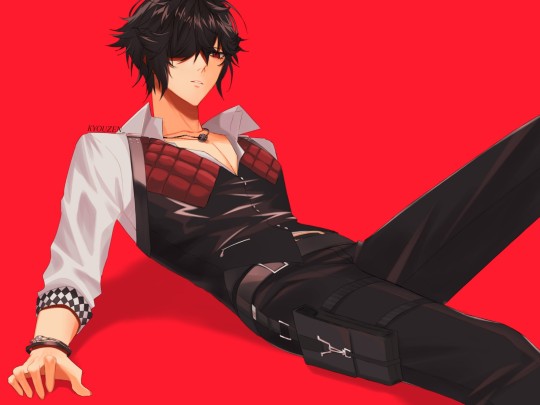
297 notes
·
View notes
Text

Code Vein OC 👀👉👈
(that I also use for dnd...)
#art#digital art#illustration#digital illustration#character art#character illustration#character concept#original character#oc#my ocs#code vein#code vein oc#code vein oc art#dnd oc#✨️woman✨️#my art
13 notes
·
View notes
Text
Wavelength
Inspired by this art from @hiemaldesirae, this art from @ectochoir, and this post by @liulith
Might become an AU or a fic but this is such a fun concept
TW for mild blood and gore.
Vox first starts noticing something is wrong when he begins losing chunks of time.
It's little moments at first. A conversation here and there. Then entire meetings, movie nights, dates. A whole afternoon just...gone.
He chalks it up to exhaustion. Velvette is always saying he's overworking himself. That's it. That's all it is. He just needs to take care of himself a bit better and he'll be fine.
Vox really begins to worry when he wakes up on the floor of his bathroom covered in blood.
He can taste it in his mouth, the flesh in his teeth. He doesn't recognize the Sinner's corpse in the bathtub, flayed open and organs gone. He throws up.
The security footage is clear. He watches himself leave the tower, leaping into the power lines from the privacy of his bedroom. Hours pass before he finally returns, dragging the corpse along behind him as he heads towards the bathroom.
He remembers none of it.
It takes him the rest of the night to clean up the mess. He can't risk anyone seeing. This would destroy his image. How can the people trust someone who just plucks Sinners off the street for a midnight snack?
He disposes of the corpse and his ruined clothes. How would he explain this to Val and Vel? He can't. He can't explain any of it.
Things come to a head when he almost kills a Sinner on live television.
It's his usual talk show. He's interviewing an actor about his latest movie (produced by VoxTek, of course) when he hears it, like static in his mind.
Kill him
He shakes it off and continues the interview, ignoring the way his heart beat kicks up a notch.
Kill him
The stage lights seem so bright, so hot. They're blinding.
Kill him
He can hear the rush of blood through the actor's veins, see the pulse of his jugular. His claws twitch. He wants to rip it out.
KILL HIM
The actor is still speaking, but Vox can't make out what he's saying anymore. His head is filled with static and the sound of rushing blood-
Ǩ̶̨̮̾͠I̷̧̩̋̂͋Ḽ̴̀L̵͎͇̟̔͝ ̷͙̯͝H̶̫̤̿͂I̷̭͚̎͌̕Ḿ̶̤̑
Vox runs off the set without explanation. He cuts the broadcast remotely and does not stop moving until he reaches him dressing room. He slams the door. His heart is pounding. He is shaking. Sparks crackle around him wildly and he struggles to reign them in. Someone is pounding on the door. Velvette is shouting his name. He presses his hands over his receivers.
"Shut up! Shut up! SHUT UP!"
And everything goes silent.
When Vox opens his eyes again, darkness has descended upon his dressing room, the LEDs around the mirror flickering. And from the darkest corner of the room, a figure emerges. Vox glares.
"You."
"Good evening, darling!" Alastor cackles. "How is your broadcast going?"
Vox staggers to his feet. "What the fuck do you want?! How did you even get in here?"
Alastor's answering grin sends an icy chill down Vox's spine. "Why, you let me in."
"Bullshit! Why the fuck would I do that?"
"Look for yourself."
Vox does, mentally searching out every camera feed for what the Radio Demon might be talking about...and he finds it. Wide-eyed, he watches his own image enter the security office, slitting the guard's throat and tapping a few keys on the blood-splattered keyboard. He recognizes the motion enough to know it's the access code and within seconds, the V Tower is completely exposed. Vox kills the feed and looks at Alastor is shock.
"I told you," the deer says.
Vox shakes his head. "How, I...I don't remember doing that! Why would I do that?!"
"Because I wanted you to. Just like I wanted you to kill that Sinner you found in your bathtub. The actor...while annoying, I didn't truly want you to kill him. No. What I really wanted was to get you alone."
There a rush of static again and Vox's jaw snaps shut, body rigid. He can't move. He can't speak. Panic floods him. Alastor steps closer.
"I've been controlling you for weeks now. It's a splendid little trick, don't you think?" He points to the floor with his cane and Vox kneels. The microphone tips up his screen. "Imagine what I can make you do. Though you don't really have to, do you? I think I made the...possibilities very clear tonight. Of course, we could always make a deal."
Vox feels his jaw come free and he stares up at Alastor's Cheshire smile.
"You want my soul."
"Ah, so there is a brain in that flat head of yours! Marvelous! That will make this all so much easier." Alastor twirls his cane, grinning down at Vox. "So here's the deal: you can either sign your soul over to me or watch as I slowly drive your empire into ruin. I'll even leave you the souls you've collected. You can maintain your Overlord status. No one needs to know about any of this. You come when I call you. You leave when I dismiss you. You follow my commands. So..." Vox feels the control lift completely. "D̴̪͈̃o̷̹̜̎̓͘ ̸͇͙̒̌w̸͕̹̐͘e̵͈͙͆͌͝ ̸̪̜͆h̵͎̫͒á̷̠̂͆v̷͍͒̀e̴̋ͅ ̶̬́ā̸͔̻̉̈́ ̷̤̾͛̓d̴͈͖̈́̈́͝ê̵̗̈́̕a̸͈͚͉̋l̷̜͈̭̈?̶̝́̄"
66 notes
·
View notes
Text

Betelgeuse I was hugely inspired by a bunch of artists and fic writers in the fandom, as well as a few monster artists who specialize in combining different creatures into beasts that actually look cohesive. I’m not sure how well I was able to execute the vision here, but I’m really proud of it regardless! DiamondZ, nonbinary-arsonist, stinkyhorsebitch, and arbuzyansky were the main catalysts for this, so definitely take a peek at their work or give them a follow. I was initially going to submit this guy for a staff art show, but I don't want to rush the rest of it, so I'm just going to post what I have finished here. Design notes are under the cut.
In earlier drafts, I was looking into more serpentine-looking designs since Beetlejuice turns into a snake in the film. Some of the concepts I was leaning towards looked like either a lindworm or centipede, but I think mammalian fits Musicaljuice since he’s “softer” in a lot of aspects compared to his film counterpart. I may look into playing with a more snake/bug-like design in the future. Beetlejuice’s overall look is heavily inspired by Chalicotherium goldfussi, which were huge Miocene ungulates that are distantly related to things like rhinos and tapirs. Given that Beetlejuice is super old, I felt like an extinct animal was a proper fit. On a more personal level, I really like the way these guys look and it was easier to rework their body plan into something that looks carnivorous. That, and I wasn’t really vibing with other mammalian body plans, especially because I wanted something that was close in shape to a human without being apelike. Huge herbivores also have larger stomachs, which I feel is a better analogue to Beetlejuice’s body type. You’ll have to pry that man’s curves from my cold, dead hands. All his forms are chubby and soft, and I’ll fight you over it in the Denny’s parking lot. I also added some hyaenid traits, especially for the head shape and teeth. Hyenas are very social animals (like Beej, except no one can see him), and striped hyenas and aardwolves specifically have these tall crests of fur that run down their backs and back legs that they can raise and lower to communicate. I’d argue it’s fitting since Beetlejuice’s hair sticks up at odd angles and communicates his mood (intentional or not). And hyenas laugh. Granted they giggle when they’re stressed, but it still fits. I modeled his stripes off of both species as well. His hind paws, ears, and tail are all based off of those of opossums. Beej is very “trash animal”-coded, and I felt like the opossum traits would fit better with the Chalicotherium body than something like a raccoon or skunk. I felt a little bad about not giving him a ton of bug traits, so I tried to add mandibles, but they just weren’t looking right in earlier design drafts. I gave him a bunch of small eyes to compensate, but making him look buggy wasn’t the only reason for the extra eyes. We know from early drafts of the musical script that Beetlejuice’s last name is Shoggoth. These creatures are mentioned by Lovecraft in Fungi from Yuggoth and At the Mountains of Madness, but I’m not sure if this implies that Beej is a shoggoth, or if it more so refers to him being able to manifest multiple limbs/shapeshift/warp reality like one. In that same vein, the mouth in his chest is mostly to look scary and is just another fun little Lovecraftian trait that I felt was needed. Same to the tendrils, but that’s also a common fandom trait that is pretty much canon (to me) at this point. I might rb this with headcanons later on.
112 notes
·
View notes
Note
I have a question
Like Crazy is probably the most queercoded in Jimins songs, right after Filter.
But the song also begins with the pronoun "She's saying Baby come and follow me"
Some fans on Twitter are saying this is a reference to a gf or something.
Whats your take on this?
Hi! Thanks for your ask. Sorry for the delay in replying! And to start, I think it's fairly clear that I don't think Jimin is straight, in my opinion, based off my views. But in that same vein, I think he also likes women. I mean, he has shared previous school crushes on a girl with us. So a "she" in the lyrics of a love song, wouldn't ever really throw me off personally. But that's just me. On top of that, Jimin did share his notes of his lyric writing process for his songs on FACE. And we can see for Like Crazy, his original planned lyrics said "baby" in place of "she." So that probably got changed for a better flow, either he did that himself, or it was suggested to him by RM, Pdogg or one of the other people who helped and gave input to the song. Either way, I don't think it's indicative of a girlfriend or an ex girlfriend in anything factual. But everyone can think what they will and have their own opinions of it for sure.
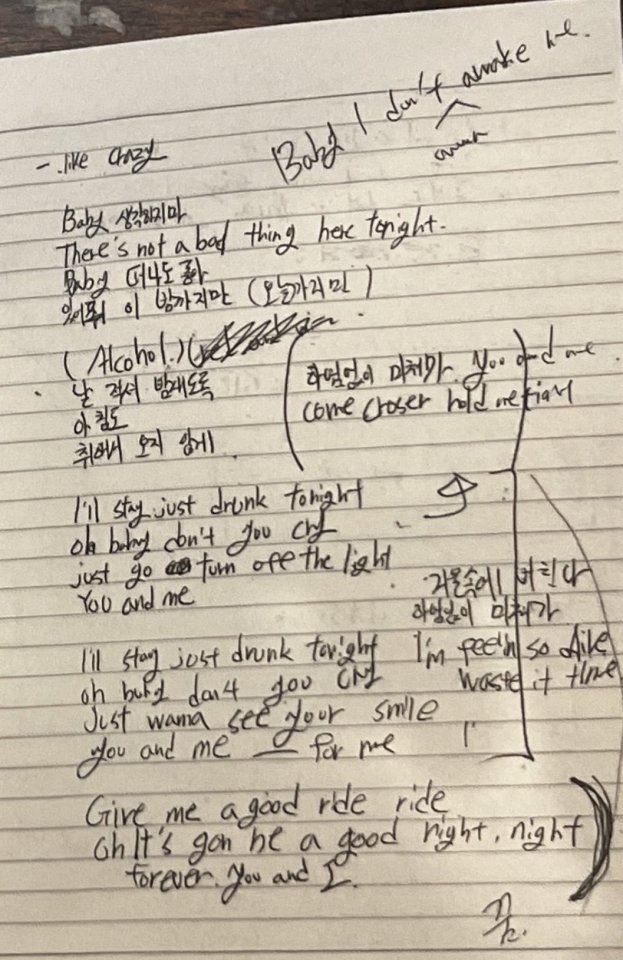
Now, for me, honestly there is a lot of queer coding through this whole MV and through subsequent performances/choreo/promotions for this song as well. Lyric breakdown can be found here before we go further:
Music Video:
youtube
And my first post about Like Crazy, where I talk about the song as a whole, what I think it's about AND touch on the queerness of Jimins gender expression throughout the MV:
To expand upon that, the choreo is a huge part of that and this person did a pretty good job breaking that down and sharing their theory over the dance too.

On top of in the extra content for FACE, similar references get lowkey pointed out in the FACE Playlist video, both in the LC MV and the Playlist video. Which you can watch here
youtube
During the Set Me Free portion, things line up very similarly to Freddie's "I want to break free" video, where he cross dresses. And for those who don't know, he fairly openly queer as an artist. He was involved with both men and women regardless of never openly stating or confirming his sexuality (that I know of). In the video, we also see Jimin looking through vinyls, including Queen and Nirvana. AND in the LC MV set, we see on the wall writing that says "Set Me Free" "Moon" "Wake" among others AND a Queen sticker too.
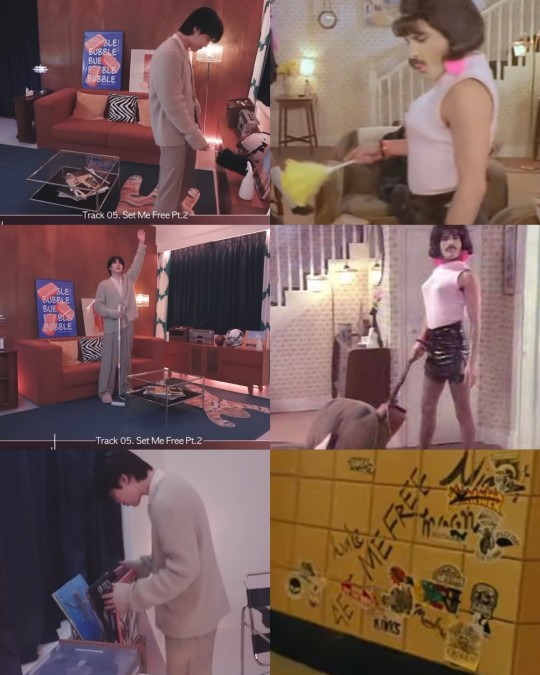
I want to break free video:
youtube
He talks and makes references to accepting both sides of himself a lot. It's in his stylistic choices, his art, how he expresses himself. And it's been a repeated theme for AWHILE now and if you aren't seeing it... it's because you don't want to

To get deeper into it, some of the historic queer imagery and iconography Jimin used in this MV specifically and just in FACE promotions in general... would include Philip Johnson, the architect of the Glass House, openly gay and where the term "the glass closet" was coined from. A photo of his is once again in the FACE Playlist video.

Robert Mapplethorpe, his portrait on the jeans Jimin wore through the MV and several images in his photobook I believe too. A photographer specializing in male and female nude works, among other things. Including his most controversial work being his documentation of the gay male BDSM subculture scene.

In the photobook, he is pictured several times in an outfit where he is wearing Jean Paul Gaultier y/series Bodymorph jeans. Specifically he is wearing the "woman" set. The designer Specifically described this series as exploring and playing with the concepts of gender, he liked the idea of there being a mens set, and a womens set and them being able to overlap each other. The bodymorph clothing sets have naked human body prints on them. So!Yoon who recently worked with and is friends with RM (if not friendly with the other members too) also recently wore these in her album release as well. You can interpret him wearing these as you choose of course. I personally think it's speaks fairly clearly to the same things I was talking about above, with him referencing all things gender and how he is leaning into the more typical feminine iconography here with these pants for his softer side of the photoshoot for his album.

I think looking at the designs for both sets also makes it more clear which ahem, set, Jimin is wearing too. Lol and how some of the models are mixing the sets (including So!Yoon wearing the women's set as well in a diff color)

And lastly, while it might not have to do with the album directly, it does involve Jimin and is worth mentioning here as it was lowkey part of album promotions. During the first ever performance aired of Like Crazy on the Jimin Fallon show, Jimin worked with 8 backup dancers and one of them was nonbinary and shared their experience and how comfortable, welcoming, non judged and appreciated Jimin and staff made them feel the whole time. How they got to just be who they were the whole time. It speaks the type of environment Jimin cultivates around himself all the time.
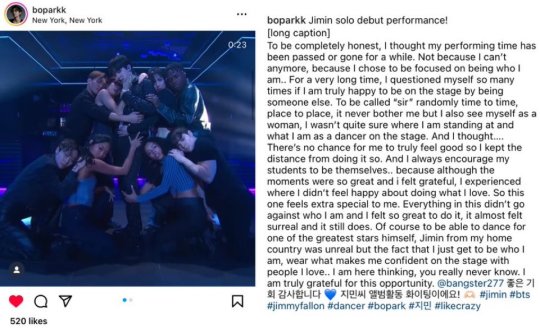
Performance video:
youtube
And during the teaser that was shared of Jimin working on his album with Pdogg and others. They talked about how for 10 months, Jimin basically lived in Pdoggs house. They all just lived together and ate, slept, breathed this album. Lol and in the hallway of Pdogg's house, we see that he has a Stonewall rainbow art piece. Which if that is what that is, is very special to have the education over Stonewall and the support of for that in your home in Korea. I won't speak to it either way, if that is what it is, great. If it's not. I'm just going to enjoy a rainbow in the same shot as Jimin regardless. Lol

Teaser video:
youtube
At this point, there is deep references to historic queer iconography in so much of Jimins art, it's fair to say we aren't guessing anymore. He is as out as he can be without explicitly saying anything. For me personally at least. And no one is owed an explicit coming out from anyone for any reason. If you listen to what he says, what he sings about, what he photographs, what he dances, what he shares with us? It's all right there too see. So plainly. Queer people have always had to talk and listen between the lines. It's there if you want to see it. And it's fair for queer armys and queer people to react and talk about the continuous use of queer icons and imagery Jimin has used over the years. It's not assuming anything. It's just listening to what he is telling us and sharing.
Thank you for the ask. And thanks to anyone who read the whole thing. 💜
199 notes
·
View notes
Note
LOUIS CODE VEIN DID NOTHING WRONG EVER, HIS ONLY BAD THING IS BEING DEPRESSED and looking a tiny bit scary, HE DESERVES 100% NICEYS, HE'S EVEN REPENTING FOR A CRIME HE DIDNT EVEN DO!
Look at him in this concept art
That's a good guy, he just wants everybody to live, and it's not his fault he is a vampire zombie
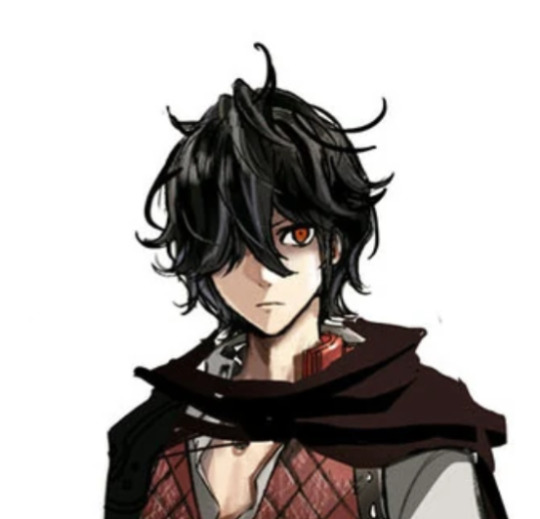
Thank you, elf
7 notes
·
View notes
Note
One of these days we're going to see fan art of your OCs
My friend drew concepts of Jacquelyn a few years ago after reading her first story and me giving her notes on her appearance.



The second picture isn’t made for me and I don’t know where my other friend found it but it’s genuinely how I pictured Carmine; especially the two toned hair. The eye color is obviously different but this art still shocks me for existing.

Somewhere I have poor photos of me making several of my OCs using the character creator in Code Vein too.
13 notes
·
View notes
Note
Hi fellow doll, I hope you're doing fine. I've been quite busy lately, college and life in general have been kicking my ass, so I was forced to take a step back from social media for a while to try to contain the chaos.
Firstly, I'd like to share a fun fact with you! I don't know if you're aware but did you know that Lou's Mansion has a Pool? You can see it more clearly in the Mansion's Concept Designs/Art on this site:
•https://www.claytonstillwell.com/ugly-dolls#23
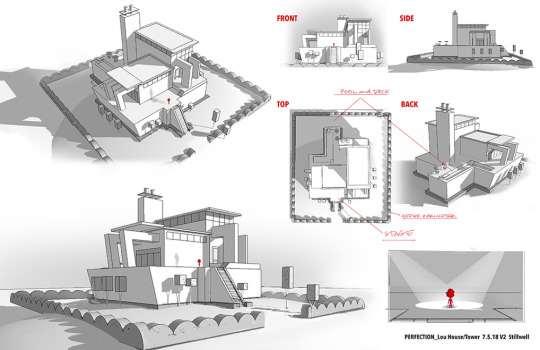
However, the real reason for this ask is to present a possible answer/theory in regards to how the doll-sized phones came to be in the world of your stories (you can tell this is still related to our chat on Wattpad).
Recently, I came across the images you're seeing on Pinterest. They're Wide/Aerial Views of the Institute of Perfection and one thing that immediately stood out to me is that Giant Eye-Catching Dome behind the TV.
I mean what's its purpose, why is it even there to begin with and what's inside of it? I've been thinking about this for a while and would like to hear your thoughts about it as well, if you're willing to share them.

By any chance, have you seen the movie Wreck-it Ralph? There was a part where the villain enters the code of the game he's in and I think the Dome's purpose could follow a similar, if not equal, vein.
Now that I think about it, Lou and Vanellope's circunstances are almost identical, trapped in the same place for years without the option to leave, simply because of who they are and the traits they were born with, but didn't choose to have.
Sorry, I let my mind run on tangent there for a while, it wanders frequently which makes it hard to keep track of my line of thought.
To circle back to the main topic of discussion, what if the Dome is a Central Station of the Institute, like a Panel or Center for Command Control (or Command Control Center)? CCC for short? Ok, I'll stop trying to be funny...

Perhaps it could be a subroutine of the factory's software, a program linked to its network and wifi that contains all guidelines and rules that govern the Institute and must be followed and executed to keep it functional - a blueprint if you will - and is in charge of all commands, protocols, activities and operations being compiled and run by its machinery, such as the doll-scanner, the robots, the washing machine, the recycling, the Gauntlet plus the mechanical baby and dog and the Portal, just to name a few.
This means that it'd also take care of overseeing the integrity and performance of said machinery as well as its maintenance. It'd even be responsible for generating clouds and the artificial weather because apparently weather is still a thing, even though the Institute is inside of a factory.
I wonder if this subroutine would be run by an AI or simply an intelligent system/computer program. This world's version of Siri? 🤣
Or maybe I'm greatly exaggerating its function/letting my imagination run wild and it literally only gives Electricity for TV and Institute. Where was I going with this? /were we again?
Morever, it could be a storage unit that contains all collected, analysed and reviewed data regarding the inhabitants of the Institute and their responses, physical or emotional, to certain pre-determined stimuli.
It could also have a list of the factory's Perfection Standards: what consists/constitutes a Perfect Doll / product, its traits...
what can go to the market and which flaws/imperfections can't be ignored/overlooked and have to go to the recycling immediately, kinda like separating fruit/food
To sum up, it's the Institute's "rulebook", but instead of being specifically made for the prototype, it's more expansive and focuses on the Institute as a whole.

After the events of the movie, dolls with engineer role job created phones with recicled parts dangerous/turned the recycling into a good thing/while recycling was turned of and parts are human sized, plenty to spare and create phone since dolls come back now, have free time to assemble the parts and construct them and connected them to the signals/frequency emitted by the dome or they hack/steal or find out the password/'hijack' the signals🤣, use it to make them connect with each other but can't enter the dome without proper authorizations/permissions
Fun fact #2: Lou animatronic, would be a hipocrite if he called the Uglydolls "Ugly" has never seen a Mirror before
•https://www.indigobluepencil.com/ugly
Scroll almost to the middle (pre-planned concepts: dome by TV and washing machine, Big baby, Lou, Mandy, Tuesday and Kitty, Victoria, Perfection Council/of Dolls=board of investors directors reference)
•https://www.scottfassett.com/uglydolls-gallery
Had to restart Two Times... I hope you found this ask both entertaining and informative. Hopefully it'll give you Inspiration for your stories...

Okay, I had to do quite a bit of research and asked someone who knows a lot more about computers than I do.
So, I do agree that the dome has an electronic purpose. It really surprises me that STX animated an entire dome within the Institute and literally spoke nothing of it or what's inside of it. Like, seriously, it's huge and can't just be empty on the inside.
My theory, after some research, is that the inside of the dome is essentially a hard drive computer tower. For you younger folk who weren't raised in a 90's home, here's what I'm talking about:

These things right here used to be what would get hooked up to older Dell/Windows computers. The ones that weighed, like, 50 pounds and took up an entire desk.
Instead of a dvd player (which I didn't get one until maybe 8 years old) I would stick my Kidz Bop cd or movie into that slot at the top and watch the movie on the computer with Video Player.
Count your blessings.
But this is what I believe is inside that dome. These things are what holds the CPU (central processing unit), GPU (graphic processing unit), and stores the memory, data, audio, and everything of the computer.
@natalie-the-writer and I have a running fanon that the company is older. The technology is older, the building is older, and everything is set in a pretty retro time period. So, this hard drive tower is connected to those bulky take-up-all-the-space-on-the-desk-computers.
The GPU in this system is also what control the day/night cycle in the Institute and the weather. It essentially simulates a troposphere and an environment that makes the dolls comfortable and prepared for the Big World.
The CPU is how the data is transferred. Info from the robots is controlled and processed, the Individualization scanners are monitored, the portal is opened and closed, the TV runs, and the holographic tutorials Moxy and her friends see in the beginning are kept on, all of it.
It basically functions as the brain of the Institute, but the sole controller and monitor of it is the CEO (Greyson Everett).
I also like to think that Lou's microchip (another fanon thought between Natalie and I) is also monitored via this hard drive tower. Any information that Lou learns and processes is sent into separate files on the computers back in the company building.
This is why in my Shell-Shock series, when Lou's emotions go south, the Institute begins to get windy when he's hyperventilating or rains when he cries. The ground trembles when he has body tremors and the lights flicker when his powers are used. He is literally connected to the whole Institute because his microchip and its data accidentally grow and manifest themselves into the files of the other Institute functions. His programming basically goes rogue and infects the Institute system like a virus.
I'm veering toward the explanation that results in Lou being the first successful form of Artificial Intelligence. But, for the moment, he is basically acting like a virus and it's not until he learns to control this new system he's connected to that it stops becoming a deadly thing.
#uglydolls#lou#writing#ask#answer#theories#fanon theories#feel free to have your own thoughts#I'm just ranting#this is so interesting thank you for asking this
27 notes
·
View notes
Text
How to Write a Fantasy Novel Based in East Asia

Introduction
Imagine a world where dragons soar through the skies, where warriors wield swords with deadly precision, and where magic flows through the veins of the land. This is the world of East Asian fantasy, where ancient myths and legends come to life in vibrant and colorful ways. If you're a writer looking to create your own unique story set in this rich and fascinating world, then look no further. In this guide, I'll help you explore everything you need to know to write a fantasy novel based in East Asia.
Before we begin, it's important to acknowledge the vast cultural diversity of East Asia. This region includes countries such as China, Japan, Korea, and Vietnam, each with their own unique histories, traditions, and mythologies. While it's impossible to cover every aspect of this diverse region in one guide, I'll do my best to provide a broad overview of some of the key themes and elements you might want to consider when writing your own East Asian-inspired fantasy.
So, let's dive in!
Section 1: Setting the Scene
The first step in creating a compelling East Asian-inspired fantasy is to build a rich and immersive world for your characters to inhabit. This means taking the time to research and understand the historical and cultural context of the region you're drawing inspiration from, as well as incorporating elements of mythology and folklore.
For example, if you're writing a story set in ancient China, you might want to consider incorporating elements of Taoist philosophy or exploring the legend of the Monkey King. If you're setting your story in feudal Japan, you might draw inspiration from the samurai code of bushido or the tales of the legendary ninja clans. Whatever your chosen setting, be sure to immerse yourself in the history and culture of the region to create a world that feels authentic and engaging.
Once you've established the cultural context of your story, you can start to think about the physical world your characters will inhabit. This might include creating detailed maps of your fictional world, inventing unique flora and fauna, or describing the architecture and landscapes of your chosen setting. Don't be afraid to get creative here – by incorporating fantastical elements like floating temples, enchanted forests, or spirit realms, you can bring your world to life in exciting and unexpected ways.
Section 2: Crafting Your Characters
As with any story, the characters you create are the heart and soul of your East Asian-inspired fantasy. To create compelling and believable characters, it's important to draw on the cultural and historical context of your chosen setting, as well as incorporating elements of mythology and folklore.
For example, if you're writing a story set in feudal Japan, you might create a samurai character who embodies the values of bushido, such as honor, loyalty, and courage. Or, if you're setting your story in ancient China, you might create a character who is skilled in martial arts and draws on the principles of Taoist philosophy to guide their actions.
When crafting your characters, it's also important to consider their relationships with each other. In East Asian cultures, family, community, and hierarchy are often highly valued, so you might incorporate these themes into your story by exploring the dynamics between your characters. For example, you might create a protagonist who must navigate the complex social hierarchy of a samurai clan, or a group of travelers who must learn to work together to overcome a common enemy.
Section 3: Incorporating Magic and Mythology
One of the most exciting aspects of writing an East Asian-inspired fantasy is the opportunity to draw on the rich mythology and folklore of the region. This might include incorporating ancient gods and goddesses, magical creatures like dragons or kitsune, or exploring the concept of qi or ki energy.
When incorporating magic into your story, it's important to establish clear rules and limitations for your characters. This might mean defining the sources of magical power in your world, such as through meditation or the use of enchanted objects, or setting limits on the types of spells or abilities your characters can use.
Finally, remember that mythology and magic are often deeply intertwined in East Asian cultures. By exploring the myths and legends of the region, you can add depth and richness to your story, while also drawing on powerful archetypes and symbols that resonate with readers.
Disclaimer
I wanted to make sure to note, that it's heavily important to research the culture your inspired by. Many experts will be offended by misinterpreted cultural or even religious aspects that are misused. Especially if it's an individual born in the region your inspired by. So please be educated especially if for example if you're writing a chinese-inspired fantasy novel, and you're not chinese. It's heavily recommended to research cultural-appropriation, the history of the culture. the stereotypes and racism East-Asians go through on a daily basis. Thank you. - Ren T.
Conclusion
Writing a fantasy novel based in East Asia can be a daunting task, but by drawing on the rich history, culture, and mythology of the region, you can create a world that is both engaging and authentic. By setting the scene, crafting compelling characters, and incorporating magic and mythology, you can bring your story to life in exciting and unexpected ways. So, don't be afraid to dive in and explore this fascinating world, and let your imagination run wild!
Copyright © 2023 by Ren T.
TheWriteAdviceForWriters 2023
#writeblr#writerscommunity#writing#writing advice#writersnetwork#writersociety#writing inspiration#writers of tumblr#writing tips#aspiring author#thecompletenovelcoach#novelcoach#bookcommunity#book coach#writing class#writing community#writing coach#writing courses#authors on tumblr#authors#new writers on tumblr#writersofinstagram#female writers#writers on tumblr#writingcoach#fiction#women writers#writerscorner#creative writing#writers block
18 notes
·
View notes
Text

Code Vein Official Setting Art Book.
#code vein#code vein concept art#io#code vein io#soulslike#soulsborne#fromsoft#dark souls#fromsoftware#elden ring#bloodborne#concept art#soulsborne concept art#art book
31 notes
·
View notes
Text
AI Art For Procedural Generation in 2022
Can you make a roguelike with GPT-3?
I find the discussion about "AI art" incredibly annoying. People talk past each other about an ill-defined concept. They put forth impassioned but bad arguments for what should in my view have been the null hypothesis. Trolls use this opportunity to pick fights with furries and insult artists with MFA degrees. It's just bait.
Many arguments are too general, they prove too much: If you think that all copyright is fake and you'd rather live in a world where Tesla can ignore the GPL but you can use Disney characters, then come out and say so. Don't talk about whether something currently is "fair use" or legal if you are making a moral argument (about what should be legal), or vice versa. If you say that people should not "waste" their time painting pictures or writing novels and painting should only ever be a hobby and not a career, I don't think it's worth responding to. If you think that Midjourney "learns to paint just like a human artist", then don't say anything.
I know I risk attracting trolls by even touching this topic, and a lot of this is so stupid because it happens on twitter, not because of the subject matter, but I think I can offer a unique perspective and conclusively answer at least one particular question: Should text-to-image AI art and neural network text generation as it exists today be used for procedural generation in computer games?
No. It shouldn't. It can, but it shouldn't. It can be used, but then you'd just do it so you can write "made with state of the art AI generation" on the back of the box.
The term "AI Art"
I am using "AI Art" to refer to text-to-image systems such as Stable Diffusion, Dall-E 2, Midjourney, and so on. I think "AI Art" is a misnomer, and there should be a different term that refers to the thing "AI Art" refers to, such as "language model combined with reverse image recognition" or "transformer+GAN based statistical learning" or "text prompt based big data image generation".
It's easy to define what "AI Art" is not. "AI Art" is not backed by AGI, not backed by symbols, does not use taxonomies or ontologies. Those systems are based on neat ideas, but the products we see are often scruffy and full of hacks and special cases to guarantee certain results.
Game AI
In a similar vein, "Game AI" is a misnomer. Most "AI" needed in games is just simple state machines and A*. Occasionally you see something like STRIPS, e.g. HTN or GOAP, or very simple reinforcement learning, or pre-trained neural networks.
But games do not need to be intelligent. Game design can be intelligent, and then the intelligent stuff is hard-coded. NPCs don't need to be smart and unpredictable, they need to be well-written, or balanced, or predictable enough for the player to know how to protect them during escort missions.
AI opponents don't need to be smarter than the player. They should be just smart enough to post a challenge, but that challenge can also be created by giving the opponent more resources.
AI techniques in games are used to fill in the blanks in player input through unit pathing and similar systems, but those are usually not called "Game AI".
(I said this all before, so I am not going into more detail)
Procedural Generation
Procedural content generation at run-time - PCG for short - is used in games to make every run, every match, or every play session unique. If you are a game developer deciding whether to use procedural generation, you are acutely aware of the trade-offs that can be made here, and why you would or wouldn't do PCG. If the game is meant to be played only once, you can generate content procedurally, but there is no need to do so at runtime. You could generate some candidates, choose the best one, tweak it, and ship it with the game. Procedural generation allows the game world to extend infinitely in all directions. But does it need to? The boundaries between "randomised" and "procedurally generated" are vague and fuzzy.
Most procedural content generation is just simple combinatorial picking: "Red Mace (+3) of Valor" could be a weapon by picking a colour, noun, and suffix, plus a damage modifier appropriate to the part of the dungeon the player is in, plus some kind of final check to make sure nothing too game-breaking is generated.
Most procedural generation in games is not based on general-purpose AI, but instead uses purpose-built algorithms that are inspired by AI techniques, or employ some kind of AI technique or algorithm as one pass of a multi-step process: To design a level, you could generate rooms, connect rooms, check room connectivity (the AI step), place furniture, place monsters, place loot, and so on. There is no need to throw all your level design constraints into a discrete solver, it suffices if you use a much more specific generation algorithm, or even an ad-hoc process that may or may not satisfy those constraints, with a check in the end.
Most procedural generation in games has tweakable input parameters.
The reason for all this is that PCG is there to surprise the player, to provide variety within tight constraints, to make different runs or playthroughs of different players unique, but not so unique that it becomes a different game every time. Procedural content generation uses building blocks that were carefully designed, and puts them together according to rules the player doesn't know, but he recognises that the output follows familiar patterns. PCG creates slightly novel or merely randomised situations that are clearly legible to players. PCG creates parameterised content that fits into existing game mechanics and systems. Prompt-based systems using deep neural networks are not as good at generating pieces that fit into systems as GOFAI-inspired systems and scruffy, ad-hoc hand-written generators.
Output
Games usually can't work with raw text, whether generated by GPT-3 or scraped from the web. They can't work with unlabelled images, whether generated by Midjourney, Creative Commons search, or returned by a Bing Images query (Google don't even let you use their image search through an API) .
AI art generators don't output rigged 3D models, and they usually don't output the same character from different angles, in different light, or making different expressions. They output multiple candidate images. Those images need to be assessed and filtered.
Text generators might output a quest when prompted to. That blob of text is useless to game systems. What kind of action is needed to complete the quest? These parameters need to be parsed out of the text.
Would you have to ask GPT-3 questions about the thing it just generated in order to use it in your game?
Input
How do you prompt these things? How do you prompt for a dwarf character, an elf character, and a human in the same art style? How do you prompt for a level, for a floor plan, for a book? Do you have to input all background knowledge and lore every time?
Do you generate text and feed the generated text into the image prompt? If you have quests and items, do you verbalise game systems? Do you need to mark special game constructs as important so they appear in the output?
If you generate images from images, can you verbally ask the AI to adhere to certain animation constraints?
Adaptability
Procedural generation systems usually have many dials you can fiddle with, parameters that are easily adaptable. In dungeon generation, I can think of the size of a room, the length of a corridor, the backtracking behaviour, the chance to spawn a set piece. All those can be tuned to the gameplay mechanics, and gameplay parameters like drop rates and monster spawn chances can in turn be tuned to level geometry.
Maybe your game can generate a room that looks like a trap, or it can show you a sleeping ogre with an unknown treasure chest in a side room, and a main path with some traps and puzzles. The game would know to put a (+1) sword in the main path, and a (+3) sword in the ogre challenge room.
I don't know how to do that with language models, text-to-text or text-to-image. Maybe I could have a long paragraph of exposition about game difficulty when I talk to GPT-3.
Randomness
How would you inject randomness into the generation process? Sure, you could just rely on the internal state of the neural network being slightly different each time. That might risk generating three samey outputs and one wacky one.
How can we generate interesting ideas? How can we generate Captain Chihuahua, a pirate dog with a coffee mug for a hand?
One way would be to randomise the prompt, to generate a prompt from a grammar, so we have a ninja horse, a cowboy chicken, and a pirate Chihuahua. Generating those via GPT-3 and then feeding them into image generation might prove difficult, but using a grammar limits your options and defeats the purpose of "advanced AI".
You could of course reach into the network (well, if you have it running on your local machine and understand how it works), and access a compressed distributed representation, latent space, sparse autoencoder, whatever non-linear thing that looks like principal components except non-linear and makes for impressive grant proposals. Then you take the vector for "chihuahua" and go from there into a direction in latent space where no training example had gone before, to generate an eldritch lizard Chihuahua. Then you feed that vector into your language model and hope you get a sensible string of text to refer to that thing.
You could generate a random visual style
With regular PCG, you can put a random texture on a random animal, resulting in a dog with scales that walks like a chicken. Imagine you could generate the eldritch lizard Chihuahua with AI: Would that make for better gameplay?
Bowls of Oatmeal
It should be easy enough to use Dall-E or Midjourney or Stable Diffusion to generate grass textures. I can even imagine a procedurally generated art gallery based on procedurally generated prompts, a procedurally generated family tree based on procedurally generated family members, or a procedurally generated library full of books written by GPT-3. None of those examples really interact with the mechanics of the game, but they fit perfectly.
I could also imagine a game where character portraits are generated according to exact specifications, but nobody notices that the game is randomised. The problem is not just that it all looks the same, but that it doesn't add anything.
Making it Work
I am sure some enterprising game devs will make it work in the near future. They may generate a library of books, or a city of NPCs with unique faces, or a visual novel where all the visual parts are generated from text.
I am also sure somebody will build an "AI art" system that generates fully rigged 3D characters or 2D characters with alternative facial expressions based on just a text prompt. It's only a matter of hooking up already-existing systems, and feeding in lots of training data.
Heck, I myself could build a procedural animation system that uses neural networks, character traits, and emotional states to procedurally generate body language. It wouldn't be cheap or easy, as I might have to pay actors to act out scenes in mocap suits, or pay click workers to annotate body language and posture in random movie clips, but it could be done. But I could already have done that ten years ago. Machine learning where you have a funtion with inputs and outputs and you train the machine to approximate the function based on examples - that's not new! The whole point of language models and text-to-image prompt-based generation is two-fold: You can use a lot of unlabelled data to train your big model. You even don't use any labels or input-output pairs to use the model. To train a neural network, I say f(po-tay-toe)=po-tah-toe, f(eeh-ther)=aye-ther. In the world of GPT-3, you say to-may-toe and the AI figures out the rest.
I could also imagine, like I said in the preceding paragraphs, generating text prompts from a grammar (but why not just generate the text then), parsing generated text and doing image segmentation (but why not parse a text or scan an image from a corpus), or doing some funky vector space structure stuff (I know the mathematical terminology, but I am deliberately being vague here, because it doesn't matter to this argument which type of embedding or representation or encoder we would use). But all that would just use machine learning to do things I can do without machine learning, in a more complicated way, to put them into a world that is based on gameplay code that has more in common with old-fashioned AI more than with modern machine learning systems.
Uses for AI art
So we can't really use AI art for procedural generation. That doesn't mean AI art can't be used at all. It can obviously be used to generate characters, props, and environment art with a human in the loop. If you want to one-shot generate a pirate Chihuahua with a coffee mug for a hand, and you can't draw well enough to do your idea justice, then AI art is a way to get there. You could use any of the dozens of image generation systems to make characters and backgrounds and then manually rig them, select what fits into your style, make sure the characters don't all have the same face, and refine your prompts so you can generate everything in the same style.
But what you absolutely cannot do is let a computer decide whether a Chihuahua would wear pants on two legs or on four, or if instead maybe the coffee mug is carried around the neck of his first mate, who happens to be a St. Bernard.
11 notes
·
View notes
Text
. . .
Due to a lot of things, and the fact I just needed a distraction, I took a hiatus. I'm actually STILL recovering from my time in the Hospital, but it's nothing significant.
Those who follow my channel know I've been on a Huge CODE VEIN kick for a while now... it's Halloween and I just felt in the mood for being ALL ABOUT VAMPIRES.
Vampire History permeates Guilty Gear, but there's barely any aspects of the story that really discuss that history... I wish I could rectify that in a later post, but we'll have to just wait and see what Team Red actually bothers to do in the future.
I know a lot of people don't like my views on what is canon versus what is accepted canon and Gaiden as a concept... and even more people don't like my views on distinctions on what is confirmed versus what they think is obvious when it comes to controversy over characters' ethnic appearances... Just understand that I just want the facts, and only the facts.
Even for the case of President Vernon E. Groubitz, GG Strive barely mentions his background, even if the "obvious" can be claimed about his history by fans' headcanons.
At this point I feel I should just stop "dying on this hill" as friends have suggested and just let people think what they want.
Discussing GG Lore with people is still something I'm willing to do... but I think at this point there's a lot of people who have their own takes on that history... so unless you want mine, I'll just leave things be.
I'm just one historian, in the end... so what I say and my views are still mine, I suppose... but just understand my purpose: to filter out all the things that distract from the truth behind that history. Even the history behind its authors and creators... some of whom we haven't heard from in a while (I'm still keeping an eye on Toshimichi Mori, even if he's technically left ASW).
Fighting games aren't the only genre I enjoy discussing lore on, but I think for the purposes of this blog, I will stick to what I am most passionate about.
Friends have suggested I make a new blog, but I'm not sure how far in I want to go for that... for now I'm just more or less focused on sharing content that I think more people should get exposed to. Whether that content is videogames, or music, or art, or something else that could engage and inspire someone.
In the lull between GGST DLC releases, I've been playing other games and reflecting on what's needed from me to contribute to this community as a fan... well, it's not much (even if I have a history of overdoing things).
Just be patient with this old man and I'll think of something cool to do later on to share with everyone.
2 notes
·
View notes
Text
KEITH TYSON
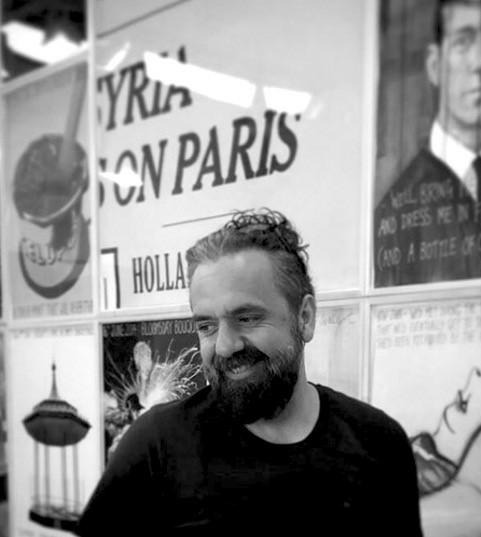
Keith Tyson is a British artist born on 23 August 1969.(1) Geno Pheno, a new collection of paintings and sculptures by British artist Keith Tyson, was exhibited at PaceWildenstein, 534 West 25th Street, New York, from October 15 to November 12, 2005.Geno Pheno is both Tyson's first exhibition with PaceWildenstein and his first significant solo presentation of his work in America since 1993.The exhibition was accompanied by a full-colour catalogue, which included an essay by Michael Archer, author, speaker and professor of art history and theory at the Ruskin School of Drawing and Art at the University of Oxford.Tyson records a generative scheme on the left panel of the two-panel paintings, and on the right panel, he generates a single probable conclusion.He has also assigned the system to sculpture, using the “base” as the Genotype and the “sculpture” as the Phenotype. Although Geno Pheno studies take many different forms, the transformation process is always clearly evident.Examining several of the new works, Michael Archer writes in his essay, “It might be more accurate to say that there are not merely two but three parts to each work. Inevitably, the phenotype as a working out of the genotype’s potential will be understood to reflect back upon the genotype from which it stems, illuminating more fully its fundamental nature. He uses many techniques such as painting, drawing and installation in his works. Geno Pheno explores the essence and limits of artistic creativity in a bold and humorous way, beginning with the traditional diptych form. A piece's genotype, or the genetic material of the work, and phenotype, or the physical manifestation of that material, make up each two-part structure. In terms of sculpture, Tyson represents this dual duality with the plinth and the object, and the paintings are diptychs that mirror one other. Tyson uses the concepts of genotype and phenotype to examine the theme of causality in the Geno/Pheno series. A genotype is a generative system that encodes for one of several possible outcomes in genetics. Despite coming from the same generative system, these results, or phenotypes, are all quite different from one another. Tyson pairs two elements, one of which takes on the role of a genotype and the other of a phenotype, by using the basic coding system seen in nature. Tyson has produced twenty-seven paintings and eighteen sculptures in this series. The two complementary elements that make up each of these pieces are the Genotype, which is on the left and is a generative system that encodes for the Phenotype, which is on the right. The artist's continuing preoccupation with the beginnings of matter and the limitless possibilities created by chance is evident in the Geno/Pheno series. According to Tyson, paint is a medium that can be programmed to respond to certain social and aesthetic cues. In his paintings, he incorporates them into text, mathematical symbols, mythology, and pictorial language. Even though he frequently creates works in rule-based series, he says that his ultimate goal is for every single piece to develop into its own universe, complete with its own set of laws, aesthetic, and purpose.(1)

TABLE – (3)
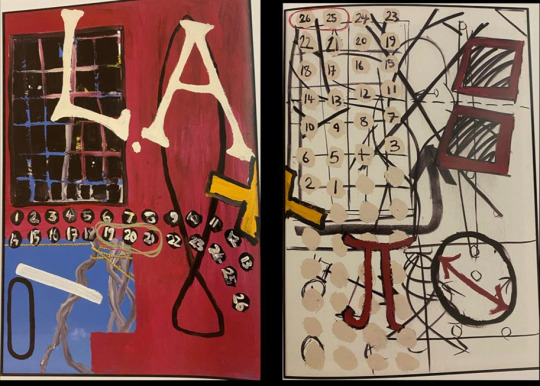
-A DIPER MINING OF THE CASUAL VEIN-(3)
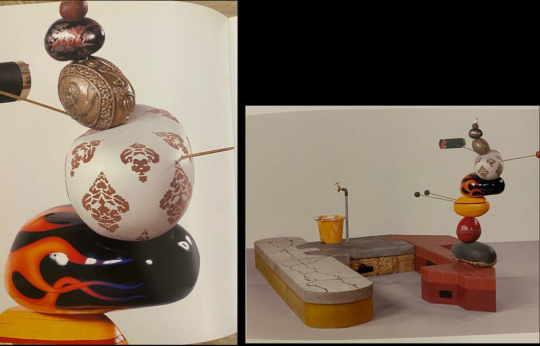
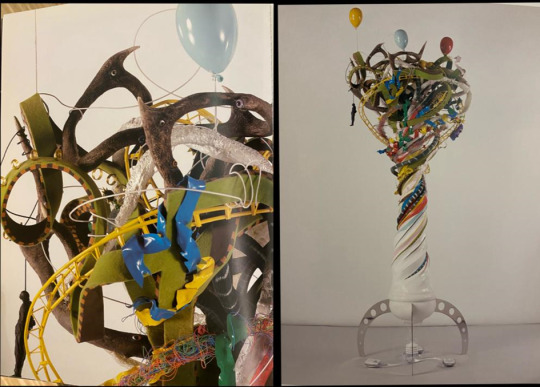
-SYNAESTHETIC TURBINE- (3)
References
Keith Tyson - Hauser & Wirth. (2023, August 7). Hauser & Wirth.
Keith Tyson: Geno Pheno on artnet. (n.d.)
Archer, M., & Tyson, K. (2005, January 1). Keith Tyson. Haunch of Venison.
0 notes
Text
With this past Tuesday being Jay-Z's birthday (Happy Belated HOV Day to all who celebrate 💎), I figured no time is better than this week to chat about my choice to make J's Magna Carta Holy Grail album "Hidden Figures"'s running musical inspiration .
.
The idea came to me when "Holy Grail" happened to pop on while I started drafting my first blog post for the series where, in a raw emotional state - as I tried to figure out how I was going to put my views and experiences about my Seattle existence into words - my longing yet conflicted feelings were underscored by the early lyrics of the song:
"...And, baby, it's amazin' I'm in this maze with you I just can't crack your code One day, you're screamin' you love me loud The next day, you're so cold One day, you're here (Yeah), one day, you're there (Yeah) One day, you care (Yeah), you're so unfair "
.
The words seemed to sing what I felt about living as a transplant in this city where it seemed I just couldn't find my way into it; I couldn't find where I belonged. And when I felt like I may have, the feeling wouldn't seem to stick or last.
.
But as the song continued, I found myself encouraged - as I am at every listen - by Jay's second verse where, after reflecting on the things that drive him crazy about the position he's found himself in thanks to fame, he steps out of the frustration to remind himself how far he's come and who he is despite those things following him:
.
"Why you mad? Take the good with the bad Or throw the baby out with that bath water You're still alive, still that nigga Nigga, you survived, still gettin' bigger"
.
The song seemed to ride the same emotional waves I found myself on as I looked to explain how "Hidden Figures" came to be: Confusion, hurt, disappointment...but then reflection, resolve and eventually emboldened acceptance and a doubling down on who I know I am. Despite the tougher feelings I found myself working through as I sought to talk about the project and what its concept was born from, I had to remember that - even in the face of those feelings - I've learned so much about myself, my values, what genuine relationships mean to me and have accomplished many things I could be proud of in this city...
.
Originally I only planned to introduce the first figure set with "Holy Grail", but as I continued listening to the album while I typed away, I heard more and more themes that reflected the things I wanted the piece to speak to: Being a Black figure existing under the White Gaze ("Oceans", "F.U.T.W", "Somewhereinamerica"), knowing my worth ("Picasso Baby", "fuckwithmeyouknowigotit")...each figure had its own theme so it only made sense for each figure to be presented with its own theme song.
.
Along with the album speaking to similar themes to Hidden Figures, it also seemed fitting that one of my most art-for-art's-sake works would be paired with what, I think, is one of the most artistic of Jay-Z's projects at the time MCHG was released (a view not everyone shares but, you know....). As a long time fan, the musical arrangements, the deep lyrics but also the quintessential rap boast tracks, the cover artwork, even Jay-Z's performance of Picasso Baby at the Pace Gallery - the album felt art house, a capsule of Jay being seen through a curated rap lens. And in the same vein, Hidden Figures is a capsule of all the feelings I've had as a transplant in Seattle delivered through a traditional Fine Art lens: No character or story to watch unfold - just a concept and (hopefully) moving and simple yet evocative shapes in a open space with something to say - a further engaging with and appreciation for the art form.
.
Magna Carta Holy Grail spoke what I didn't have the words to say and said everything I left out of the words I did have. And I guess at the same time, in a way, my use of the album is also my own little lover letter to and celebration of one of my favorite lyricists and rappers of all time whose music has held a place of honor in my life for a long time.
#jay-z#magna carta holy grail#rap#rap blog#black artists#theme song#music#shawn carter#beyonce#Spotify
1 note
·
View note
Text
youtube
Colors of Pride (2020), performed by the Nu Quintet
Program Notes: Out of the many things I draw inspiration from, queerness is the most personal. Being both openly gay and non-binary, I find my own queerness and the concept of being queer deeply influential in how I create my art. One of the most enduring symbols of that being the pride flag.
The current, most widely used version, of the flag, has six colors and each has a different meaning: red is for life, orange is healing, yellow is for sunlight, green is nature, royal blue is serenity, and violet is spirit. When approaching a piece about the pride flag I was confronted with how to best represent these ideals. How does one write music that invokes healing? Within the piece, the first five movements have an emphasis on specific instruments: the flute is life, the clarinet is healing, the horn stands in for sunlight, the oboe represents nature, and the bassoon exemplifies serenity. The final movement, spirit, is a group endeavor, with all the instruments working more as a cohesive whole, playing on the idea of spirit to mean more in the vein of 'spirit of togetherness.'
Each movement has a unique, but related, way of arriving at the pitch material, in that I used RGB codes to form the basis of the music. For example, 255, 0, 0 is red in the purest sense in RGB. So, I took 255, translated it into D-F-F and there is my life-motif. Orange is 255, 127, 0, which translates musically to the clarinet line beginning with D-F-F C#-D-G-C, and so on. (The final movement, Violet, is a bit of a misnomer because to achieve the atmosphere I wanted I had to use the color code for Deep Magenta!)
This piece was commissioned by the Plaza Winds Quintet as part of my residency during the Fall 2020 semester at the UMKC Conservatory of Music and Dance.
This piece received an Honorable Mention in the 2021 Morton Gould Young Composer's Competition.
Link to purchase the score can be found here
Blaze
0 notes
#Youtube#contemporary classical#classical music#composer#queer#queer music#queer artist#lgbt#lgbtq#lgbt pride#woodwinds#woodwindquintet#quintet#pride flag
0 notes